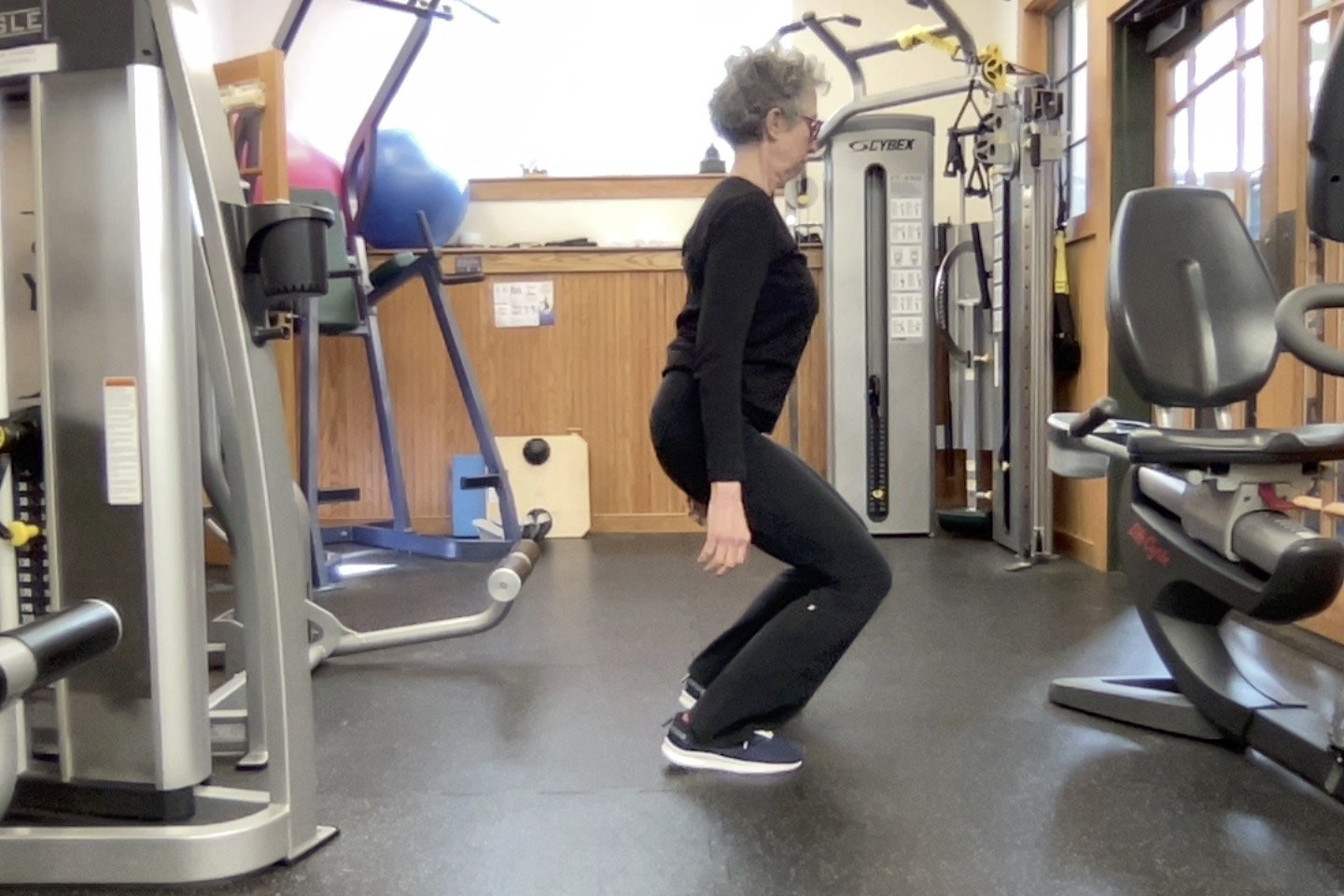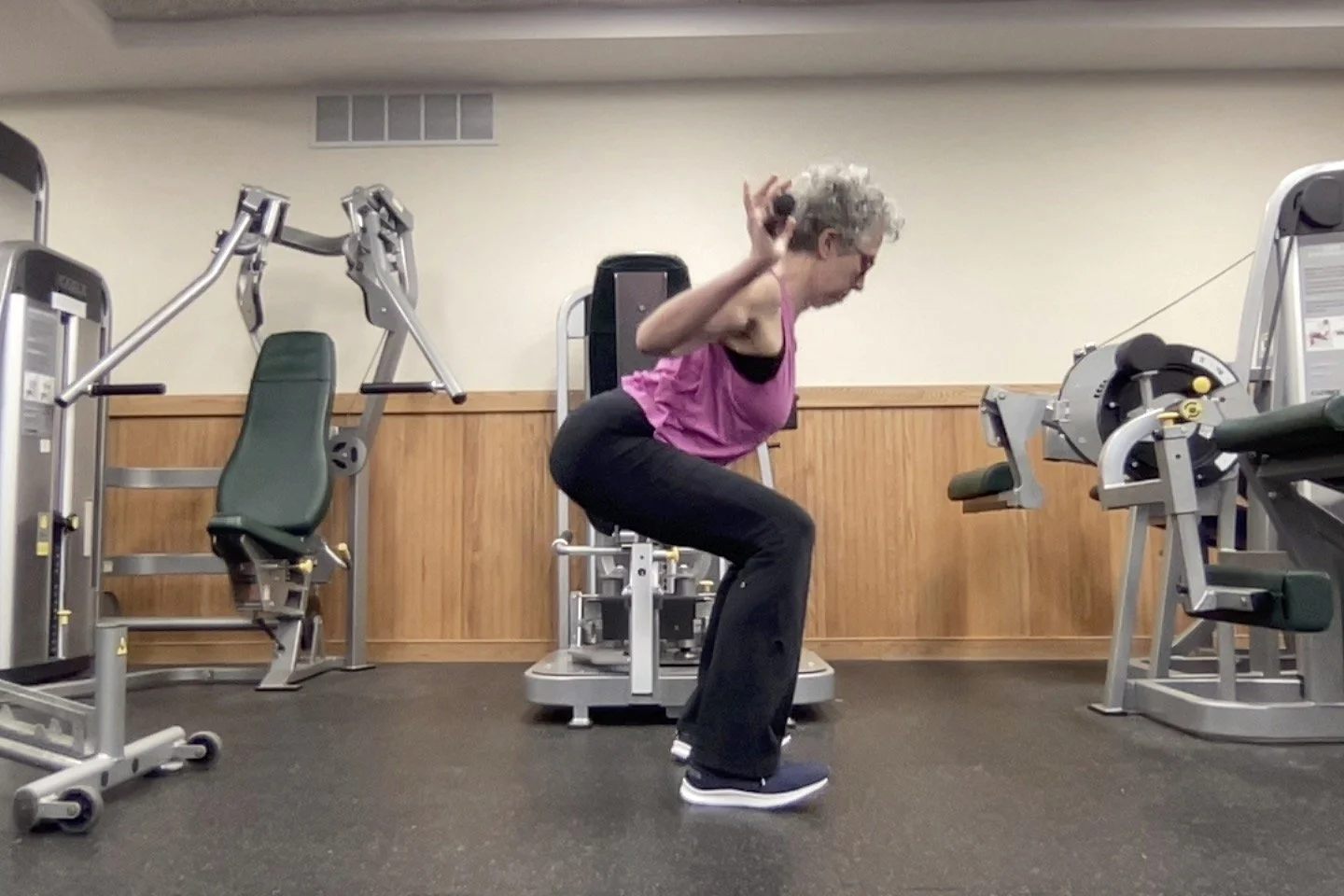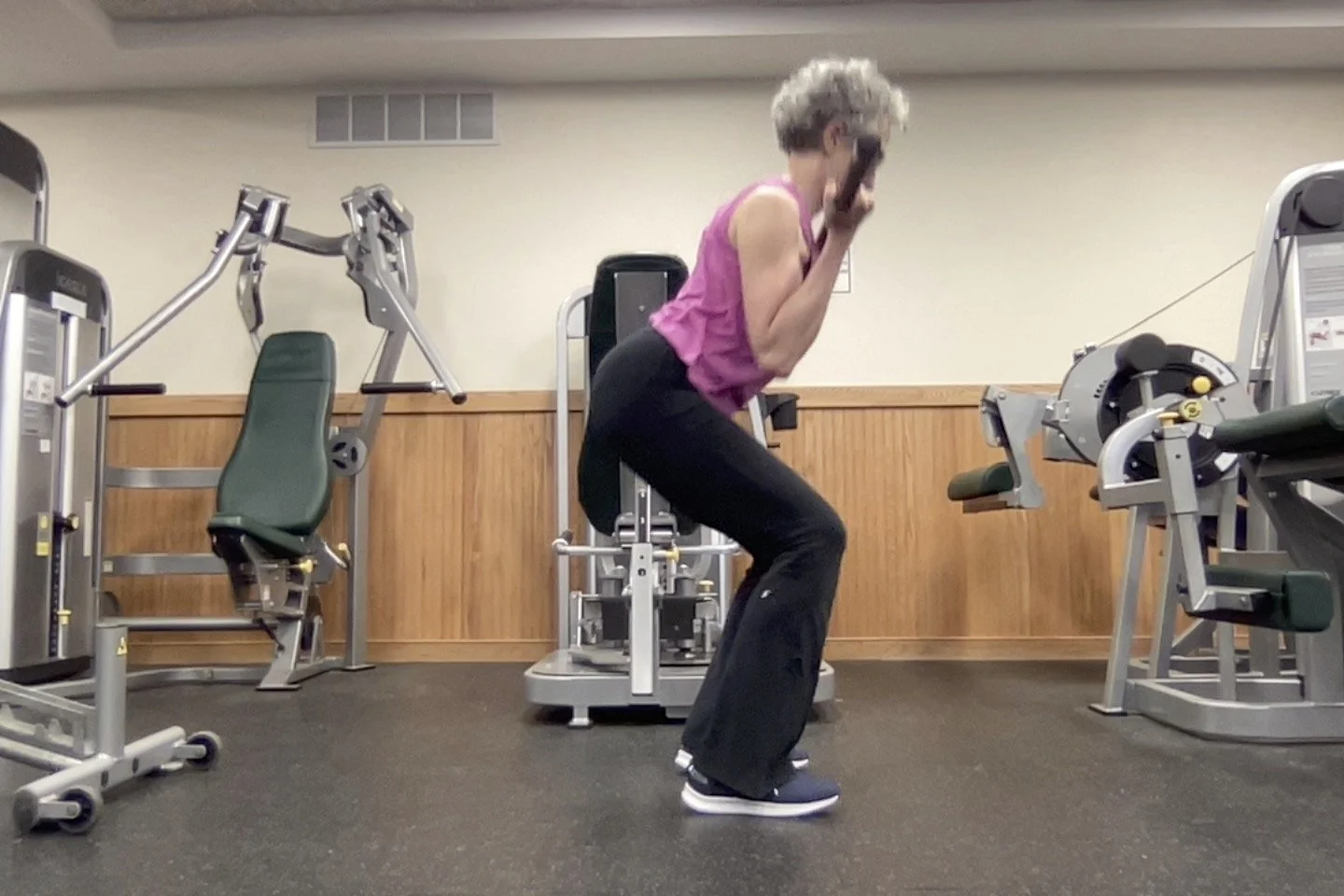HOW TO DO SQUATS STEP BY STEP
My observation from my years of personal training and working out in various gyms is that nobody knows how to squat. Okay, that is an exaggeration, but I've seen some damn funky squats in my day. Here’s my best imitation above. It is a funny thing for people not to do well because it is an everyday activity. It's called sitting. When you sit down in a chair, you are, essentially, doing the lowering movement of a squat. When you get up, yup, the lifting motion of a squat.
If you'd like to start squatting, please check with your doctor to make sure they believe squatting will be good for you. Confirming is particularly important if you are recovering from an injury.
I also like to remind people as they try something new. Do everything in your comfort. Squatting shouldn't hurt. If it does, stop and investigate. Remember this advice when you are working out, everything to your comfort. Challenge, heck yes, pain, no, thank you.
We call it squatting in the gym.
We call it Chair Pose in Yoga or Utkatasana.
Hips
Knees
Ankles
That's what's bending. But how and where? Ah, there is the rub.
Why Do I Need to Squat?
It is a compound move that is very good for you. It works multiple muscles engaging the core, quadriceps glutes, hamstrings, and hip flexors. It is a profound mobility exercise because of what you are learning to bend and engage. As reported in the New York Times, "The benefits are not confined to the lower body. "It is really a whole-body exercise," said Silvio Rene Lorenzetti, the director of the Performance Sports division of the Swiss Federal Institute of Sport in Magglingen. "It requires core stability and trains the back." But will a squat hurt my knees? Your squat-happy author has significant arthritis in her right knee. Motion is lotion. Our joints are designed to bend. Movement maintains flexibility and stability in the three squatting joints: hips, knees, and ankles.
We do, in fact, squat all day long when we sit and stand and when we engage in many activities such as gardening, cleaning the house, getting in and out of cars, getting up and down to eat, watching t.v., read, knit, doing sports, and other activities. The good news is we can learn to do it better for the health of our muscles, bones, and joints, not just when we are in the gym, but all day long.
Squatting Step by Step
You don't need a gym. With your hand on a railing or a wall or standing free, you can hinge your hips, bend your knees and ankles, and squat. It works wonders because it is a bodyweight exercise. You are lowering and lifting your body weight as you squat and rise.
A great way to get started is to use a chair. Stand in front and sit down. You are likely to squat correctly because that is the most natural way to sit down. You can add the challenge of not quite sitting down and rising back up as you practice.
You can stand with your feet hip's width or shoulder's width apart. Go with what feels good to you. Later, we'll get to variations like squatting with a narrow stance (feet touching) or a wide stance (wider than shoulder-width.) Your foot stance is critical. Start with your toes slightly outward and heels slightly inward. Keep your feet connected to the floor. Some people tend to curl up their big toes or more toes. Connect from toes to heel to the ground for a solid base.
Place your hands on your waist or hold your arms straight out in front of you. In Yoga, we might put our palms together in front of our heart in Anjali Mudra or lift our arms on either side of our ears. The latter position adds load to the effort, so figure your squat out first.
Stand tall, draw your tailbone down and engage your core lifting your belly button toward your heart. Relax your shoulders, lengthen your neck and lift your crown toward the sky. Look straight forward. Like many of us, I often catch myself looking down. We do want to keep our neck in line with our spine.
Place your hands where you wish, press your feet down, and hinge at the hips to squat correctly.
Let's be specific about what is moving and how you can increase your awareness and feel the motion.
Place your hands on the bony points of your hips or ASIS (anterior superior iliac spine). They are in front and to the side of your lower abdomen. We find it helpful to be specific about the parts of your body so you can become more familiar with the healthiest form and movement. A bit geeky, but not un-useful.
The hip points help us learn how to hinge at the hips. We've noticed that we don't all do this naturally. Some of us bend at the waist. Maybe stand now and experiment. If you want to squat, are you hinging at the hip or bending at your waist.
Imagine someone is karate chopping you right below your hip points to hinge at the hip.
Or/And imagine you are trying to sit in a chair. If uncertain, go back to experimenting with a chair right behind you.
Hinge at your hips first as you bend your knees. We find this order brings us to the correct position. If you squat by bending your knees first or without hinging at the hip, it will pull your center of gravity forward.
Let's pause at a common problem you may have heard of called butt wink. BW is the rounding of the lower back as you come into the squat, typically because you are tucking your pelvis at the bottom of the squat. You may find that you don't wink your butt at a higher level of a squat and only start to tuck your pelvis as you try to get deeper. Practice will make perfect as you watch out for that tuck as you slowly seek to deepen. Take it slow and steady as you make discoveries. Seek to lengthen your spine and maintain your natural curves as you squat. Engaging your core will help you to keep your spine neutral.
Keep your head and chest lifted and your spine long. Avoid rounding your spine. Look straight ahead. Sometimes people unconsciously drop their chest to feel lower to the ground. Keep your chest lifted. You are sending your hips and knees closer to the ground.
Center of gravity is key. I'm pinning my feet to the floor and keeping my weight toward my heels.
Everyone will be slightly different in how much their knees move. Mine tend to move slightly forward toward my feet. I have seen many people squat by simply bending their knees without hinging at the hip, and they often end up with their knees way out over the toes. How do those knees feel out there if that is your habit? For me, they are uncomfortable. Remember my early suggestion to stay within your comfort. Try hinging at the hip as you bend your knees. Your knees are moving toward but are not out and over your feet. Now, exactly where your knees will land when you squat depends on the length of your bones and body structure. I will trust you to find a position where your knees feel good and not bad.
We recommend that your knees track toward your foot. We don't want to allow our knees to sink inward or outward. Aim toward your second toe.
Check out the pictures.
I look like someone karate chopped me below my hip points.
My hips move back.
My knees bend, tracking my feet.
My ankles bend.
I'm standing tall. My crown is reaching forward. My back is long. My neck in line with my spine.
My core is lifted.
My chest is lifted. My shoulders externally rotated. We'll talk about those two points more in another installment.
My feet stay connected to the floor – ball, and heel.
My arms might be straight out in front of me, they could be by my ears in a classic Chair Pose, and they could be in prayer position in front of my heart. Heck, my hands could be on my hips.
Arms as you wish, just, please, pretty, please, don't send your knees out over your toes.
Let's review posture. The tailbone is reaching down, not curving up or forward. The core is engaged. The crown of the head is reaching forward, neck in line with your spine. Imagine your whole spine lengthening as you hinge into your squat. Dancers think of lifting their torso out of their hips to lighten their legs. Stay connected to your feet.
Below is a proper squat.
What's working? Gluts, for sure. Quadriceps. By necessity, the core is working. Hamstrings are working, too, tucking right up into those glutes. And your back is long, allowing for your natural curves to activate the whole host of pillars of support, including multifidus, quadratus lumborum, and psoas. I never studied Latin, but I enjoy learning and knowing the proper names of our muscles.
How low do you go? As low or high as you want to go. There is no rule here. Do you. What feels comfortable to you. I've been sitting like a catcher for my whole life and still can. That's me. You might be happier with a shallower squat. Note: When you go super low, you will likely lift your heels, but not essential. Do what feels right.
This whole conversation has assumed we're doing a bodyweight squat without anything on our back or in our hands.
How Many Types of Squats are There?
Quick answer, a lot. We hear many different names, even for the same move, and there are several options where we add props and weights.
Air Squat is what I've described. A bodyweight squat.
Wall Squat – same idea with your back against a wall.
Wall Squat with Fitness Ball – Place a fitness ball against your lower back and lean into the wall. Squat rolling your hips under the ball. This is an excellent way to get in the habit of hinging your hips.
Plié Squat – Plié is a ballet move like a squat, but with a different shape. You will bend your knees and ankles, but you won't hinge your hips in this case. As you lower, your knees will bend out over your feet. In ballet, you may do a demi and a grand plié. It is easiest to picture the bigger gesture of grand plié first. It is a full knee bend bringing your thighs to parallel with the floor as your heels rise. Note that if you stand wide apart in second position, your heels will remain on the ground when you plié. Your heels lower to the ground as you straighten your legs. In a demi plié, you bend your knees about half as deep as in a grand plié and leave your heels on the floor.
Whether standing with our heels together and our toes out in first position or standing hip or shoulder width or further apart in second position, we like to add on the following challenge:
1. Plié lifting heels.
2. Straighten legs keeping heels lifted.
3. Lower heels to the ground.
4. Lift heels.
5. Bend knees to lower into plié
6. Lower heels.
7. Straighten legs.
8. Repeat cycle as many times as you like
Wide Stance Squat – Try standing wider than shoulder-width apart with toes pointing slightly outward.
Narrow Stance Squat – Place your feet side by side. You can even touch your big toes together.
Let's turn to equipment.
Goblet Squat: Hold a Kettlebell or Dumbbell in two hands at your chest.
Barbell Squats: There are two forms - back squat and front squat.
Back Squat: Lift a weighted barbell and place it on the back of your shoulders. Back squats target your lower back, glutes, and hamstrings. Naturally, your core and quads also contribute.
Front Squat: Hold the bar in front of you on your shoulders. The front squat focuses on the front of your body, including your quads and upper back. Your glutes and hamstrings contribute.
Smith Machine: Step into a machine with a weighted barbell.
Dumbbell Squat: Hold a dumbbell in each hand. Arms hang down. Of course, you could throw in some bicep curls if you wanted.
Have some fun squatting. Let us know how it goes and if you have any questions. This article appears on Medium - https://medium.com/@andrea_lepcio/how-to-do-squats-step-by-step-b524d60051b. Follow me there as well.







